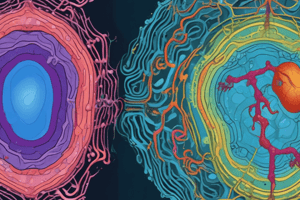Podcast
Questions and Answers
What is the main site of adenosine triphosphate (ATP) production within cells?
What is the main site of adenosine triphosphate (ATP) production within cells?
- Endoplasmic reticulum
- Mitochondria (correct)
- Golgi apparatus
- Lysosomes
What is the function of the cytoskeleton in a cell?
What is the function of the cytoskeleton in a cell?
- To store genetic information
- To synthesize proteins
- To give internal framework to the cell and hold organelles in place (correct)
- To regulate cell growth
What is the role of ATP in a cell?
What is the role of ATP in a cell?
- To store genetic information
- To synthesize proteins
- To serve as the main energy source for most chemical reactions (correct)
- To provide structure to the cell
What is the material within the inner membrane of a mitochondrion?
What is the material within the inner membrane of a mitochondrion?
What is the main function of leak channels in the cell membrane?
What is the main function of leak channels in the cell membrane?
What is the series of chemical reactions that require O2 to break down food molecules to produce ATP?
What is the series of chemical reactions that require O2 to break down food molecules to produce ATP?
What type of protein structures make up the cytoskeleton?
What type of protein structures make up the cytoskeleton?
How do gated channels differ from leak channels?
How do gated channels differ from leak channels?
What is the direction of water movement in osmosis?
What is the direction of water movement in osmosis?
What is the purpose of osmotic pressure?
What is the purpose of osmotic pressure?
What would happen to a cell if it experiences large volume changes due to water movement?
What would happen to a cell if it experiences large volume changes due to water movement?
What is the role of the selectively permeable membrane in osmosis?
What is the role of the selectively permeable membrane in osmosis?
What type of channel is always open, allowing ions to pass through the membrane?
What type of channel is always open, allowing ions to pass through the membrane?
Why is osmosis important to cells?
Why is osmosis important to cells?
Where are ribosomal subunits produced?
Where are ribosomal subunits produced?
What is the main function of rough ER?
What is the main function of rough ER?
Where do ribosomal subunits move to after being produced in the nucleus?
Where do ribosomal subunits move to after being produced in the nucleus?
What is the characteristic of smooth ER?
What is the characteristic of smooth ER?
What is the function of smooth ER in skeletal muscle cells?
What is the function of smooth ER in skeletal muscle cells?
What is the relationship between the endoplasmic reticulum and the nuclear envelope?
What is the relationship between the endoplasmic reticulum and the nuclear envelope?
What is the structure of the endoplasmic reticulum?
What is the structure of the endoplasmic reticulum?
What is the difference between rough ER and smooth ER?
What is the difference between rough ER and smooth ER?
What is the primary function of DNA in a cell?
What is the primary function of DNA in a cell?
What is the overall structure of a DNA molecule?
What is the overall structure of a DNA molecule?
What is the bonding pattern between nucleotides on opposite strands?
What is the bonding pattern between nucleotides on opposite strands?
What is the primary function of a carrier molecule in the context of glucose transport?
What is the primary function of a carrier molecule in the context of glucose transport?
What is the role of a gene in protein synthesis?
What is the role of a gene in protein synthesis?
What is the composition of a nucleotide?
What is the composition of a nucleotide?
Which of the following statements about active transport is true?
Which of the following statements about active transport is true?
What is the result of DNA directing protein synthesis?
What is the result of DNA directing protein synthesis?
What is the direction of substance movement in active transport?
What is the direction of substance movement in active transport?
What is the role of proteins synthesized from DNA instructions?
What is the role of proteins synthesized from DNA instructions?
What is the purpose of the sodium-potassium pump in active transport?
What is the purpose of the sodium-potassium pump in active transport?
What is the energy requirement for active transport?
What is the energy requirement for active transport?
What is the significance of DNA in an organism?
What is the significance of DNA in an organism?
What is the result of active transport in terms of concentration gradients?
What is the result of active transport in terms of concentration gradients?
What is the difference between active transport and passive transport?
What is the difference between active transport and passive transport?
What is the role of a carrier molecule in active transport?
What is the role of a carrier molecule in active transport?
Study Notes
Cell Membrane Channels
- Leak channels constantly allow ions to pass through the cell membrane.
- Gated channels limit the movement of ions across the membrane by opening and closing.
Osmosis
- Osmosis is the diffusion of water across a selectively permeable membrane from a region of higher water concentration to one of lower water concentration.
- Osmosis exerts a pressure, termed osmotic pressure, which is the force required to prevent movement of water across the cell membrane.
- Osmosis is important to cells because large volume changes caused by water movement can disrupt normal cell functions.
Active Transport
- Active transport is a carrier-mediated process that requires ATP to move substances across the cell membrane from regions of lower concentration to those of higher concentration against a concentration gradient.
- Active transport accumulates necessary substances on one side of the cell membrane at concentrations many times greater than those on the other side.
Endoplasmic Reticulum (ER)
- The endoplasmic reticulum (ER) is a series of membranes forming sacs and tubules that extends from the outer nuclear membrane into the cytoplasm.
- Rough ER is involved in protein synthesis and is rough due to attached ribosomes.
- Smooth ER has no attached ribosomes and is a site for lipid synthesis, cellular detoxification, and it stores calcium ions in skeletal muscle cells.
Mitochondria
- Mitochondria are major sites of adenosine triphosphate (ATP) production within cells.
- Mitochondria carry out aerobic respiration, a series of chemical reactions that require O2 to break down food molecules to produce ATP.
- ATP is the main energy source for most chemical reactions within the cell, and cells with a large energy requirement have more mitochondria than cells that require less energy.
Cytoskeleton
- The cytoskeleton gives internal framework to the cell.
- The cytoskeleton consists of protein structures that support the cell, hold organelles in place, and enable the cell to change shape.
- The protein structures of the cytoskeleton are microtubules, microfilaments, and intermediate filaments.
DNA
- DNA contains the information that directs protein synthesis; a process called gene expression.
- A DNA molecule consists of nucleotides joined together to form two nucleotide strands.
- Each nucleotide consists of a 5-carbon sugar, a phosphate group, and a nitrogenous base.
- A gene is a sequence of nucleotides that provides a chemical set of instructions for making a specific protein.
- DNA influences the structural and functional characteristics of the entire organism because it directs protein synthesis.
Studying That Suits You
Use AI to generate personalized quizzes and flashcards to suit your learning preferences.
Related Documents
Description
This quiz covers the two main classes of cell membrane channels, including leak channels and gated channels. It explores how they function and allow ions to pass through.




